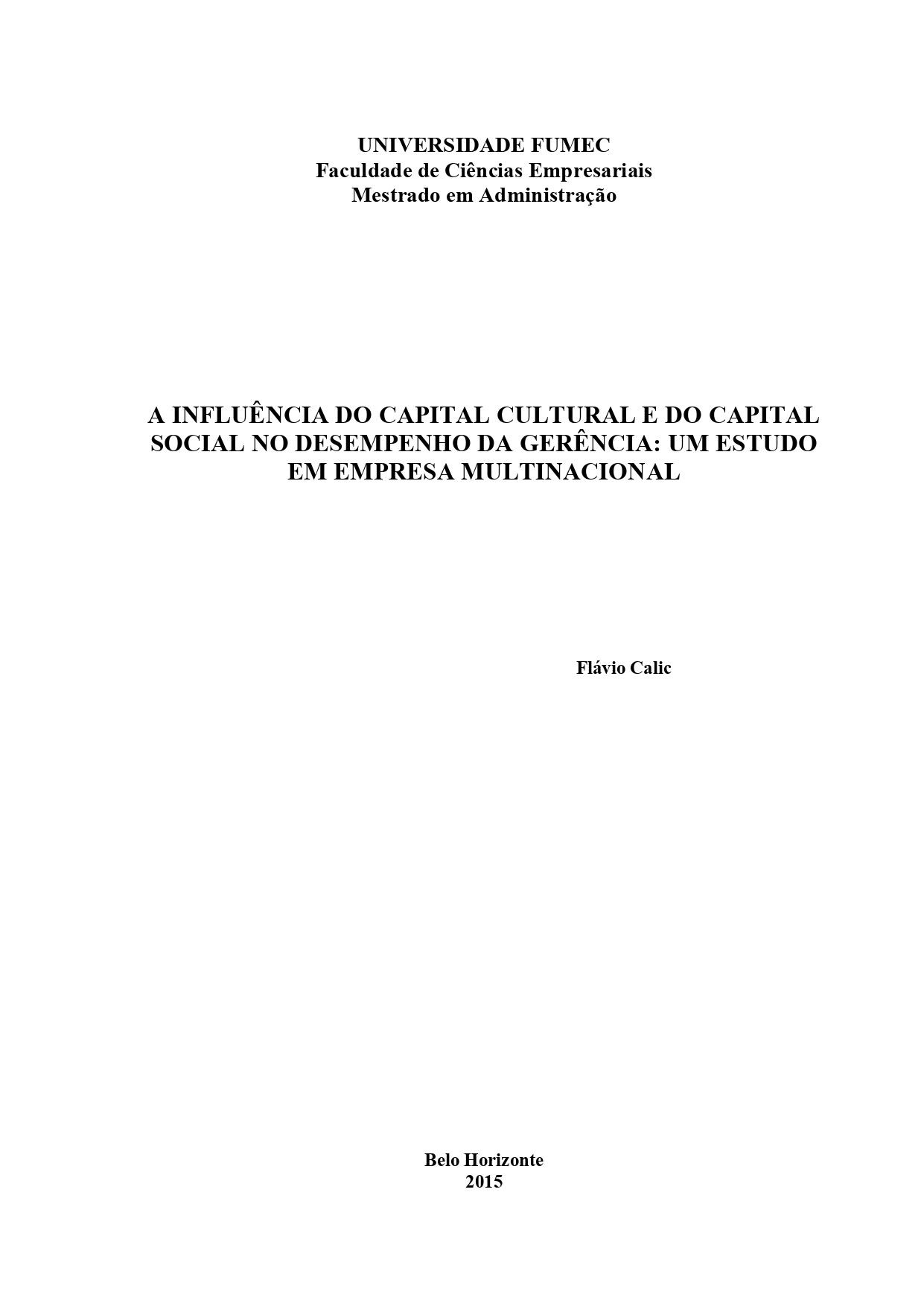A influência do capital cultural e do capital social no desempenho da gerência: um estudo em empresa multinacional

Visualizar/
Data
2015Autor
Calic, Flávio
xmlui.mirage2.itemSummaryView.MetaData
Mostrar registro completoResumo
Na era da informação, as organizações têm vivenciado transformações contínuas em todos os
seus subsistemas. Uma das mais importantes transformações foi a valorização dos ativos
intangíveis, em especial, a valorização das pessoas dentro da dinâmica organizacional.
Juntamente com isso, no intuito de cuidar e de desenvolver este novo e valioso recurso, a
liderança torna-se papel central dentro das organizações e a medição do desempenho,
corriqueira, pelo alto valor que as pessoas podem gerar dentro das empresas. Ao mesmo tempo,
muitos estudos vêm sendo desenvolvidos, relacionando os mais variados tipos de
comportamentos humanos com os capitais cultural e social. Este estudo investigou a influência
do capital cultural e do capital social no desempenho dos gerentes, contemplando aspectos do
desempenho relacionados às tarefas e, também, à liderança (de pessoas e de mudanças). A
pesquisa também teve como foco o desenvolvimento e a validação de uma escala de capital
cultural e capital social. Foi realizado um survey transversal, em outubro de 2015, com 180
gerentes de uma empresa multinacional de bens de capital. A metodologia fundamentou-se em
análises estatísticas pertinentes à validação da escala, tais como da análise fatorial exploratória
e confirmatória e por meio da abordagem PLS (Partial Least Square). Os resultados
demonstram que todos os constructos apresentaram índices de Variância Média Extraída acima
40% e Confiabilidade Composta superior a 60%, valores adequados, no caso de pesquisas
exploratórias. O constructo “Capital Cultural” apresentou um R² de 36,10%, sendo explicado
pelo “Capital Social”. O constructo “Autoavaliação de Desempenho” apresentou um R² de
39,73%, sendo explicado pelos constructos “Capital Social”, “Liderança de Pessoas”,
“Liderança de Mudanças” e “Capital Cultural”. Verificou-se, ao nível de 1% de significância,
que, quanto maior o Capital Social, maior tende a ser o Capital Cultural e também que, quanto
maior o Capital Social, maior tende a ser a Autoavaliação de Desempenho. Ao nível de 5% de
significância, verificou-se que, quanto maior o Capital Social, maior tende a ser a Liderança de
Mudanças. During the information era, the organizations have been living continuous changes in all its
systems. One of the most important changes was the appreciation of the intangible actives,
specially the appreciation of the people inside the organizational dynamic. With this, in the
intention of taking care and developing this new and valuable resource, the leadership becomes
central role inside the organizations and the performance measurement, ordinary, by the high
value that people can generate inside the companies. At the same time, many studies have been
developed, relating the most variable kinds of human behavior with the cultural and social
capitals. This study investigated the influence of the cultural capital and the social capital on
the managers performance, contemplating performance aspects related to the tasks and, also, to
the leadership (of people and of changes). The research also had as focus the development and
validation of a social capital and a cultural capital scale. A transversal survey was made, in
October 2015, with 180 managers of a multinational company of capital assets. The
methodology was grounded in statistic analysis pertinent to the scale validation, such as the
explanatory and confirmatory factorial analysis and through the PLS (Partial Least Square)
approach. The results showed that all the constructs presented indexes of Average Variance
Extracted above 40% and Composed Reliability above 60%, values suitable, in the case of
exploratory surveys. The “Cultural Capital” construct presented a R² of 36.10%, being
explained by “Social Capital”. The “Performance Self-evaluation” construct presented a R² of
39.73%, being explained by the constructs “Social Capital”, People Leadership”, “Changes
Leadership”, and “Cultural Capital”. It was verified, at a 1% level of significance, that, the
larger the Social Capital is, the larger the Cultural Capital trends to be and also that, the larger
the Social Capital, the larger the Performance Self-evaluation tends to be. At the level of 5% of
significance, it was verified that, the larger the Social Capital, larger the Changes Leadership
tends to be.
